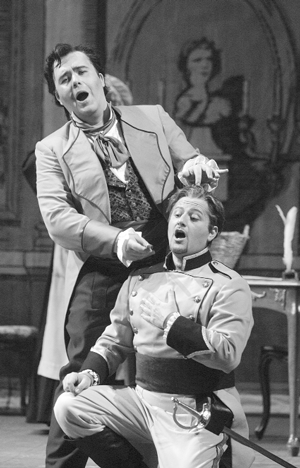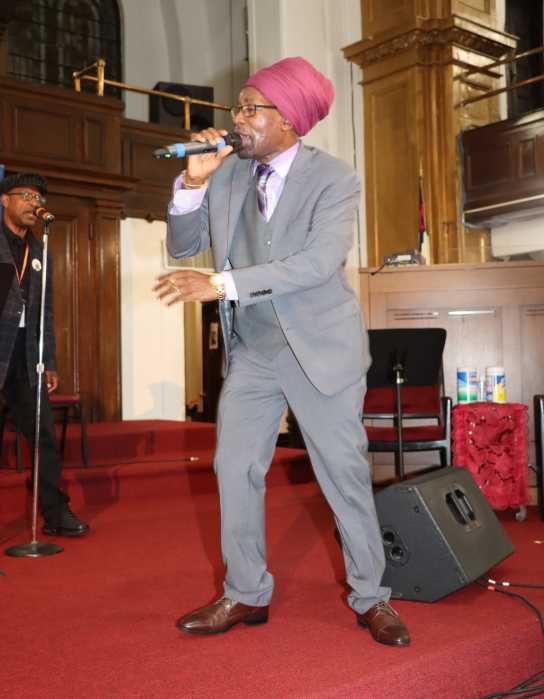Sequel and prequel operas at the Met, Opera Company of Philadelphia
Pierre-Augustin Caron de Beaumarchais’s incendiary trilogy of French plays set in Spain produced two of the masterworks of Italian-language opera—Mozart’s “Marriage of Figaro” (1786) and Rossini’s “Barber of Seville” (1816). Others accrued as well— Rossini’s work actually pushed out of circulation a hitherto popular “Barber” treatment by Giovanni Paisiello (1782); the third play, “La mere coupable” got worked up by Darius Milhaud, and the characters’ lives received further extension in both Jules Massenet’s “Chérubin” (1905) and in the opinion-dividing “Ghosts of Versailles” that John Corigliano and William Hoffmann presented at the Met in 1991.
The Mozart would be my candidate for greatest opera ever written; the Rossini certainly places among the most tuneful and sure-fire, though often subject to silly “acting funny” stagings. The Met’s Jonathan Miller production of “The Marriage of Figaro” has its problems—an unduly ugly, dilapidated Act I set and no greenery at all in Act IV’s garden. But its current incarnation, directed by Robin Guarino, minimizes some of the questionable business of yore and is generally enjoyable; though having the characters do dance steps to the catchy rhythm in the Act II finale remains an insufferably cheap, provincial touch.
Hei-Kyung Hong and Peter Mattei repeated their quality Almaviva portrayals from past seasons, each maybe a touch more challenged at the top of the range. Not quite world-class Scottish soprano Lisa Milne, who could go into “Hairspray” as Tracy Turnblad tomorrow, was a fluent, funny Susanna. My date could not take his eyes off the handsome, idiomatic Figaro, Luca Pisaroni––fortunately, the Italian bass also sings this kind of music very well! But the best performer was Joyce Di Donato, whose overdue Met debut Cherubino marked—a flawless, flowing lyric mezzo, and an original, unhackneyed stage sense. More of her, please.
Wendy White should be commended—she both looks and sounds better than in recent seasons, and has actually refined her characterization of Marcellina, a rare trend-bucking achievement. I still regret the production’s characterization of Basilio as a vicious old queen and can only wonder at Greg Fedderly’s decision to play it to the hilt.
“Figaro” returns in April, with Andrea Rost in her best Met role (Susanna), the sterling Soile Isokoski cast opposite Mattei and another promising debutante Cherubino, Alice Coote. While competent, Mark Wigglesworth, one of two new English conductors at the house this year, showed no special reason for having been imported, and one wondered how many of the talented assistant conductors on the company’s roster might have led a more interesting reading.
Opera Company of Philadelphia’s Music Director Corrado Rovaris showed his true mettle in the pit with the “Barber” (November 18), a commendable evening musically, with deft orchestral playing and a reasonably full edition. Allen Moyers’ handsome neo-classical cartoon interiors were rented from Minnesota Opera. Dramatically things were less happy, at any rate for an observer heartily sick of comic operas getting laden with pointless, routine shtick.
At least two originally announced Italian producers came and went; surely anyone who has attended OCP for a while did not need the program insert to adjudge that general director Robert Driver had taken over. Witness the trademark Gratuitous Cute Child, Figaro’s omnipresent assistant, many prancing extras, plus the chorus—and often the principals—doing “funny” movements to the beat of the music. The Academy of Music is a relatively intimate space, ideal for 19th century opera; Philadelphia’s audience has a residual component of those who understand Italian even without surtitles. Why lard every moment with sledgehammer gags?
The three central figures, all debutants, boasted native Italian, making for crisp, meaningful recitatives. Lively Laura Polverelli (Rosina) unfurled a true mezzo with a duskily handsome tone unafraid of occasional expressive asperity. Antonino Siragusa’s artfully used tenorino called to mind Ugo Benelli’s fine Almaviva; his lovely, self-accompanied “Se il mio nome” and valiant “Cessa di più resistere” were the evening’s highlights. Roberto de Candia attempted to upstage both, his nasally sung factotum an encyclopedic compendium of campy provincial stage business.
Kevin Glavin, also nimble linguistically and the rare excellent, disciplined vocalist among basso buffos, showed by contrast the virtues of restraint. Glavin’s Bartolo was often terrifically funny, but the humor came from human observation and—as with Oliver Hardy—a certain dignified stillness that preserved the character’s sense of self-worth. When will some company let him loose on Nicolai’s “Merry Wives of Windsor?” Tigran Martirossian gave one of those standard-issue post-Soviet bloc “acting weird” interpretations of Basilio with rolled eyes and waving limbs—the long influence of superstar bass Fyodor Chaliapin? Rossini’s lighter orchestration made his well-trained lyric bass appreciably audible, as it had not been in Verdian outings here. Carolyn Betty (Berta) showed a fine soprano, dominating the act finales and dispatching her aria handsomely.
Philadelphia is an easy day or evening trip from Manhattan. The season continues with the company’s co-commission “Margaret Garner” in February with the high octane acclaimed original cast (Denyce Graves, Gregg Baker, Angela Brown, Rodney Gilfry) and a May revival of—wait for it—“The Marriage of Figaro,” promising the welcome return of Christine Brandes’ Susanna, a look at another Italian comer, Simone Alberghini, as the Count plus Mary Dunleavy’s anticipated role debut as the Countess.
David Shengold (shengold@yahoo.com) writes about opera for many venues.
gaycitynews.com
































